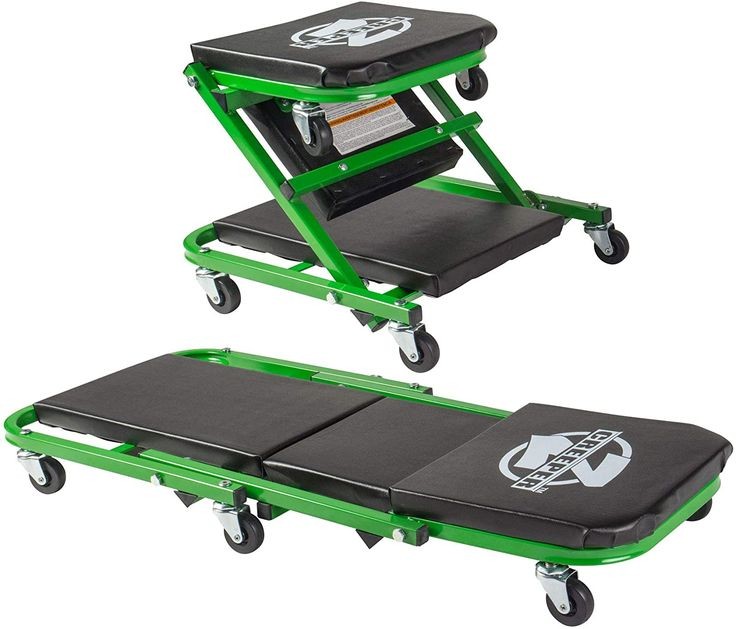Working underneath a vehicle is a necessary evil for any car enthusiast or professional mechanic. Whether you’re performing routine maintenance, troubleshooting a complex issue, or undertaking a restoration project, you’ll inevitably find yourself sliding under your car. For years, many mechanics have relied on simple solutions like cardboard or old rugs for a bit of comfort and mobility. However, as anyone who’s spent time on a hard garage floor knows, these makeshift options leave much to be desired, especially when considering back and knee strain. That’s where the Best Mechanics Creeper comes into play.
Mechanic’s creepers are designed to provide a comfortable and mobile platform, allowing you to work under vehicles more efficiently and with less strain. But with a wide variety of creepers available on the market, from basic plastic models to more elaborate designs, how do you choose the best mechanics creeper for your specific needs? This guide dives into the world of mechanic’s creepers, drawing insights from experienced mechanics and enthusiasts to help you make an informed decision and select a creeper that will truly enhance your garage experience.
Many mechanics start with the simplest solution: a piece of cardboard. It’s cheap, readily available, and offers a slight barrier against the cold, hard floor. However, cardboard quickly becomes worn, dirty, and provides minimal cushioning or mobility. As one forum user, Woody, mentioned, “I’ve always been a bigass piece of cardboard guy.” This sentiment is common, reflecting the initial simplicity and accessibility of cardboard.
 Cardboard as a makeshift creeper alternative
Cardboard as a makeshift creeper alternative
For those looking to upgrade from cardboard, the molded plastic creeper, often referred to as the “dogbone” style, becomes an attractive and affordable option. These creepers, like the Harbor Freight model mentioned by WillG80, are popular for their low cost and basic functionality. They typically feature a molded plastic body with recessed wheels and often include tool trays on the sides, a feature praised by multiple forum members for keeping tools and small parts within easy reach. WillG80 notes, “It’s the molded plastic type that goes over the wheels and has a tool storage tray on the sides which comes in handy.” Hunter47 and AnthonyGS also echoed the usefulness of these trays.
However, while these plastic creepers offer an improvement over cardboard, they are not without their drawbacks. Some users find the wheels to be small and prone to getting caught on cracks or debris on the garage floor. Adam525i pointed out that while the Harbor Freight creeper is good, “the wheels are larger [on the Bone Creeper] so they roll over stuff on the floor easier.” This highlights a key consideration: wheel size and quality are crucial for smooth and effortless movement around the garage.
Another type mentioned is the “Bone Creeper,” known for its unique design and low profile. Adam525i mentions owning one and appreciating its low profile and larger wheels. However, ShawnG and Woody noted the potential unavailability of Bone Creepers due to changes in the company, suggesting that availability can be a factor when considering specific brands.
Stool creepers offer a different approach, combining a seat with wheels for tasks that require working at a lower level but not necessarily lying flat. J_tso inquired, “How about a stool creeper? Best or worst of both worlds?” These can be useful for wheel and brake work or any task where you need to be low to the ground but still mobile and able to sit upright intermittently.
 Stool Creeper as a versatile garage seating option
Stool Creeper as a versatile garage seating option
Beyond traditional creepers, some mechanics opt for even simpler solutions like foam mats. Tom_Spangler and procainestart mentioned using anti-fatigue foam mats as a comfortable alternative, especially for those who find creepers raise them too high, reducing workspace. Tom_Spangler explains, “My problem with creepers is that they raise me up a few inches… Now I use a couple squares of foam anti-fatigue mat.” This highlights that sometimes the “best” solution is the one that best fits the specific task and user preference.
Ultimately, the best mechanics creeper for you will depend on your individual needs and preferences. Factors to consider include:
- Wheel Quality and Size: Larger, high-quality wheels, especially polyurethane wheels as suggested by bearmtnmartin, will roll more smoothly over uneven surfaces and obstacles.
- Comfort and Ergonomics: Consider features like padding, headrests (especially adjustable ones), and a center drop design for lower profile, as mentioned by bearmtnmartin.
- Durability and Build Quality: A robust creeper will last longer and withstand the rigors of garage use.
- Storage: Think about how easily the creeper can be stored when not in use, as highlighted by Woody’s comment about creepers being a “PITA to have around when I wasn’t using it.”
- Features: Tool trays are a popular and practical feature, but magnetic trays or other additions might also be beneficial, as suggested by dj06482.
While some, like TJL and bludroptop, express frustration with creepers in general, finding them cumbersome or limiting mobility when applying force to wrenches, for many mechanics, a good creeper is an invaluable tool. Choosing the best mechanics creeper involves weighing the pros and cons of different types and features, considering your budget, and thinking about the specific tasks you’ll be performing. By considering these factors and learning from the experiences of other mechanics, you can select a creeper that will make your time under the car more comfortable, efficient, and less of a pain in the back.